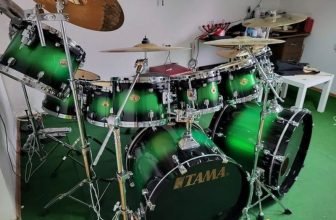
There are many reasons to extract the drum part from a song. Maybe you like the drum part on a certain track and want to learn how to play it yourself. Or maybe you want to use isolated drum tracks as the basis for a remix or new composition.
Whatever the reason, extracting a drum part from a song can be a bit of a challenge. But with a little patience and the right tools, it can be done.
4 Steps on How to Extract a Drum Part from a Song
Contents
When it comes to extracting a drum part from a song, there are a few key steps that you’ll need to take to get the perfect sound. Here’s a breakdown of what you need to do:
Step 1 Load the song into the DAW.
If you want to extract the drum part from a song and load it into your DAW, there are a few things you need to do. First, find the song you want to use. You can do this by searching for it on a search engine or streaming service, or by looking through your music collection.
Once you’ve found the song, listen to it to identify the section that contains the drum part you want to extract. Make a note of the start and end times of this section.
Next, load the song into your DAW. Most DAWs have a way to import audio files, so you should be able to find this option in the File menu. Once the song is loaded, create a new track for the drums. You can do this by clicking the “Create new track” button in the Track menu.
Step 2 Find the drums in the song
To find the drums in a song, you will need to first identify the drumbeat. Once you have found the drumbeat, you will need to accentuate it by increasing the volume of the drums or by using a drum machine. You can also try to EQ the drums so that they are more pronounced. Finally, you can add reverb or delay to the drums to create a more distinct sound.
Step 3 Use a compressor

1. Start by setting the threshold of the compressor so that it’s just barely catching the loudest hits. This will ensure that the compressor is only affecting the drums when they’re at their loudest, which is what you want.
2. Next, set the ratio to around 4:1. This will give you a good amount of compression without crushing the sound of the drums.
3. Attack and release times are going to be dependent on the tempo of the song. For a slower song, you’ll want to use longer attack and release times so that the compressor has time to do its job. For a faster song, you’ll want to use shorter attack and release times so that the compressor doesn’t kill the transient of the drums.
Step 4 Export the drums as a separate audio file
To do this, open the File menu and choose Save As. In the “Save As” window that opens, give the file a name and choose where you want to save it. Finally, click the Save button. Your drum part is now saved as a separate file.
Following these simple steps, you’ll be able to extract a great-sounding drum part from any song in no time! You can now use these drum tracks for songs or to learn a drum part.
Extract the Drums from the Song with the Help of Special Programs.
If you’re looking to extract the drums from a song, there are a few different ways you can go about it. One popular method is to use a software program specifically designed for the task (drum remover).

DrumExtract
If you’re looking for an easy and effective way to extract drums from songs, give DrumExtract a try.
DrumExtract is a program that can be used to easily remove drums from songs. The program works by first analyzing the audio file to identify the percussive elements. It then applies special filters to isolate the drums and separate them from the rest of the track.
Isolated drums track, you can then export them as a separate audio file to use however you like. You can also use DrumExtract to tweak the sound of the drums, such as changing the EQ or adding effects.
Audacity
Audacity is a free and effective option. To use Audacity for drum extraction, first, open the recording in the software. Then, use the built-in equalizer to boost the frequencies that are typically associated with drums. For example, you can boost the low end to bring out the kick drum, or boost the highs to isolate the cymbals.
Once you’ve EQ’d the track to your liking, it’s time to apply some noise reduction. This will help to remove any bleed from other instruments that might be muddying up the drums. To do this in Audacity, go to the “Effects” menu and select “Noise Reduction.” Click “Get Noise Profile,” then hit play on the track and let it run for a few seconds. Once it’s done, click “OK” to apply the noise reduction.
Now that the drums are isolated, you can export them as a separate track. Go to the “File” menu and select “Export.” Choose your desired file format and location, then hit “Export.” And that’s it! You now have a separate track containing just the drums from the original recording.
If you also need to isolate vocals audacity can do the same.
Conclusion
I hope that this article helped you find a way to remove drums from your music mix and that you were also able to get acquainted with drum removers.
After you finish extracting the drum part from the song, you get a sound that you can use on its own. It sounds like a complete part even though it’s only the drums.




